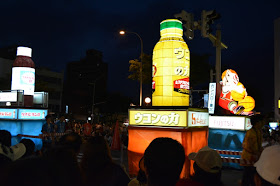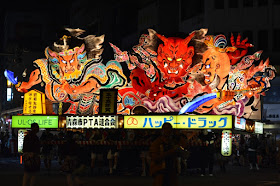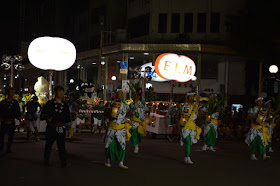As written in the previous post, hubby and I went to see Aomori Nebuta Festival on 3rd August. Aomori Nebuta Festival is an annual summer festival that is held from August 2 to August 7 in Aomori City of Aomori prefecture. This festival is considered to be one of the top three festivals of the Tohoku region and is often referred to as the most colorful festival of Japan. The festival features enormous and gorgeous lantern floats shaped after famous historical and mythological Japanese characters or warrior figures. About 20 such colorful huge floats are paraded through the nighttime streets at the center of Aomori City. Each float is flanked by hundreds of dancers called Haneto who wear unique traditional colorful costume and dance around the floats to the sounds of traditional music. Nebuta Festival attracts more than 3 million people to Aomori City every year during the six day period of the festival.
The origin of Aomori Nebuta Festival is not known and historians are divided over its beginning. Some historians believe that the Nebuta floats were invented by General Sakanoue no Tamuramaro in the 800s, when his army created gruesome creatures from cloth and bamboo to scare away the enemy. Yet there are other historians who say that the festival originated from Toro Nagashi ritual of Tanabata Festival. Toro Nagashi is a traditional event in which lanterns made of wooden frames and wrapped in Japanese Washi papers are illuminated with lit candles and floated down a river or a sea. It is believed that this ritual of Toro Nagashi drives away evil spirits and brings good luck and good health. As time passed, the size, shapes, and colors of the lanterns evolved into the present day Nebuta lantern floats. Huge floats built in the shape of figures inspired by legends and historical characters have become the prevalent form of Nebuta floats. While the historians cannot agree on the origin of the festival, it is undoubtedly one of the most visually impressive festivals in Japan. The festival was designated as a national important intangible folk cultural property in 1980 and was also recognized as one of the 100 Soundscapes of Japan by the Ministry of Environment in 1996.
As stated in the previous paragraph, the earliest Nebuta floats were dummy creatures made of bamboo and clothes, or lanterns made of wood and Washi paper. The shape and size of the lanterns have evolved with time. During Meiji period, wood or bamboo was used to make the frame of the paper lanterns and wax candles were used for light. However, the wooden frames and wax candles often caused fire during the festival and so eventually they were replaced with wire and electricity. Present day Nebuta floats are made of painted fragile Washi papers supported by hand-designed wire frames and bamboo constructs, and lit from the inside with many electric light bulbs. Also, the lantern floats of today have become bigger and much more detailed. The enormous and gorgeous floats are designed and shaped after famous Japanese gods, folklores, themes, historical characters, warrior figures, and Kabuki characters. Many floats tend to depict battles between warriors, demons, and mythological characters. Stories of gods defeating demons in epic battles are masterfully recreated in meticulous details which make for quite dramatic imagery. The Washi papers used for making the floats are beautifully and painstakingly hand-painted. As a finishing touch, hundreds of light bulbs are weaved throughout inside the floats, which illuminate the floats fantastically with amazing colors during the nighttime festival parade.
After the festival ends each year, local artists immediately get to work on the conception of the Nebuta floats for next year and spend the entire year planning and constructing the floats. The actual construction of one enormous float takes about three months and the construction cost is about 4 million yen. There are three types of Nebuta floats, namely the small-sized children’s Nebuta floats, the medium-sized regional Nebuta floats, and the large-sized local organization’s Nebuta floats. The small-sized Nebuta floats are often pulled by children and are paraded throughout the city during the first two days (2nd and 3rd August) of the festival. The large-sized Nebuta floats are enormous and can be up to nine meters wide, five meters tall, and seven meters deep. A maximum of 22 such large-sized colorful floats are constructed every year. However such enormous floats require immense strength to move, and so it is impractical to showcase them on all the days of the festival. Therefore only about 75% of the large-sized Nebuta floats are paraded on the first two days of the festival. But on other days of the festival, all the (about 20) huge colorful large-sized floats are paraded through the nighttime streets at the center of Aomori City.
Hubby and I went to see Aomori Nebuta Festival on 3rd August. As written in the previous post, Nebuta Festival was supposed to begin at about 6.30 pm but we had reached Aomori City in the afternoon itself. So we visited Nebuta Museum Warasse located near Aomori Railway Station. At about 4.40 pm, we left the museum and started walking towards the venue of the main parade event of Nebuta Festival. We reached the parade venue located in the city center at about 5.30 pm. For viewing the parade, very nice seating arrangement was done on both sides of the road along the parade route. About two weeks prior to the festival, we had purchased two tickets each worth 2600 Yen and reserved two seats along the main road. We found our reserved seats, made ourselves comfortable on the chairs, and were all set to watch the parade of the Nebuta Festival.
We passed Aomori Railway Station while walking towards the parade venue of Nebuta Festival
While waiting for the main parade event of the Nebuta Festival to begin, we had some snacks and read a pamphlet about the festival. We realized that on 3rd August, the second day of the festival, about 15 small-sized children’s Nebuta floats and 15 enormous large-sized Nebuta floats were to take part in the festival parade. At about 6.30 pm, the festival parade began with many performers and musicians playing Taiko drums and flutes. The traditional music was so nice to listen to. This was followed by the parade of many enormous large-sized colorful Nebuta floats along the road. Each large-sized float was pulled by about 50 people. One after the other huge floats paraded down the road. In between the large-sized Nebuta floats, there were parades of many children’s floats and medium-sized floats also. We appreciated the full splendor of all the Nebuta floats. The colorful floats painted with striking traditional designs of Japanese gods, folklores, themes, historical characters, and warrior figures looked absolutely stunning. We soaked in the artistry and admired the craftsmanship that went into the construction of such colorful vivid floats. The colors and the details of the floats were simply amazing and made for a vibrant spectacle. We loved seeing the parade of one gorgeous float after the other. Each float was flanked by performers and musicians playing traditional music on flutes and Taiko drums. In addition, hundreds of Haneto dancers, wearing unique traditional colorful costume and flower hats, merrily jumped and danced around the floats to the sounds of traditional festival music and chanted ‘Rassera Rassera’. It was a wonderfully spectacular sight to behold. In addition, we also saw three young ladies dressed in pink Kimono waving elegantly to the crowd as they sat in an open car during the parade. These ladies were declared this year’s ‘Miss Nebuta’ and they are responsible for promoting Nebuta Festival and tourism in Aomori prefecture. After about an hour or so of the parade, we gave up our reserved seats and moved to a different location along the roadside to get a better view of the parade of the Nebuta floats. It should be mentioned that when the parade began at 6.30 pm, it was still daytime and the sun was still out. The huge colorful Nebuta floats looked very impressive by the day. But during the parade, the sunlight gradually disappeared and the colorful lit Nebuta floats looked dazzlingly breathtaking in the nighttime. We thoroughly and immensely enjoyed the parade and it took about 2 hours to finish one round of the parade of all the Nebuta floats. We clicked many photos of all kinds of floats, Taiko drums, and Haneto dancers during the first round of the parade. We were too busy and immersed in watching the parade, and so missed taking photos of a few of the floats. Below are the photos we clicked and I have numbered the Nebuta floats for the sake of simplicity. Hope you all also enjoy the colorful extravaganza.
It was daytime when the parade of the Nebuta floats began. The parade started with Nebuta Float number 1.
Float 2
Float 3
Backside of Float 3
Float 4
Float 5
Backside of Float 5
Many Haneto dancers in colorful costumes
Float 6
Backside of Float 6
Float 7
Backside of Float 7
Float 8
Backside of Float 8
Many Haneto dancers in colorful costumes
Float 9
Backside of Float 9
Float 10
Backside of Float 10
Many flute players in the parade
Taiko drums
Haneto dancers merrily dancing
The sunlight gradually disappeared and during the parade of Float 11 it had become completely dark nighttime
Many participants pulling Float 11
Backside of Float 11
Float 12
Floats 13, 14, and 15
Float 16
Backside of Float 16
Participants playing Taiko drums
Yet other participants playing Taiko drums
Float 17
Float 18
Backside of Float 18
Float 19
Backside of Float 19
Float 20
Float 21
Backside of Float 21
Float 22
Backside of Float 22
Float 23
Backside of Float 23
Float 24
Float 25
Float 26
Float 27
Float 28
Float 29
Float 30
Taiko drums
Three ‘Miss Nebuta’ waving to the crowd
We continued watching the parade of the Nebuta floats during the second round of the parade also. Now it was nighttime and completely dark everywhere, and so the colorful lit Nebuta floats looked absolutely dazzling and stunning. We admired the artistry of the workers who constructed and handcrafted the enormous floats with painstaking details. We were overwhelmed by the colors and the details of the vivid Nebuta floats. We once again enjoyed seeing the parade of one amazingly gorgeous float after the other. It was also enjoyable to again see the performers and musicians playing traditional music on flutes and Taiko drums, and the Haneto dancers dancing with gay abandon. About quarter way through the second round of the parade, we moved to yet another location along the roadside to get a still better view of the parade of the Nebuta floats. The parade event ended exactly at 9 pm about halfway through the second round of the parade. We absolutely loved watching the parade of the Nebuta floats, which was a wonderful experience and made a lasting impression on us. During this second round of the parade, we clicked photos of only the enormous large-sized Nebuta floats. Please enjoy the photos of the colorful magnificent floats. For the sake of consistency, I have marked the Nebuta floats as numbered in the first round.
Performers playing a huge Taiko drum
Another view of the huge Taiko drum
Nighttime view of Float number 1
Parade of Haneto dancers
Float 2
Backside of Float 2
Float 3
Backside of Float 3
Haneto dancers
Float 5
Many Taiko drums
Float 6
Backside of Float 6
Float 7
Backside of Float 7
Float 8
Backside of Float 8
Float 9
Backside of Float 9
Float 10
Backside of Float 10
Float 11
Backside of Float 11
Float 16
Backside of Float 16
A few remarkable faces on the backside of Float 16
I am enjoying the Nebuta Festival
Hubby clicking photos of the Nebuta floats
Clicking away
We loved seeing Aomori Nebuta Festival. The parade of enormous vivid Nebuta floats was amazing. No wonder the festival is referred to as the most colorful festival of Japan.


















































































No comments:
Post a Comment